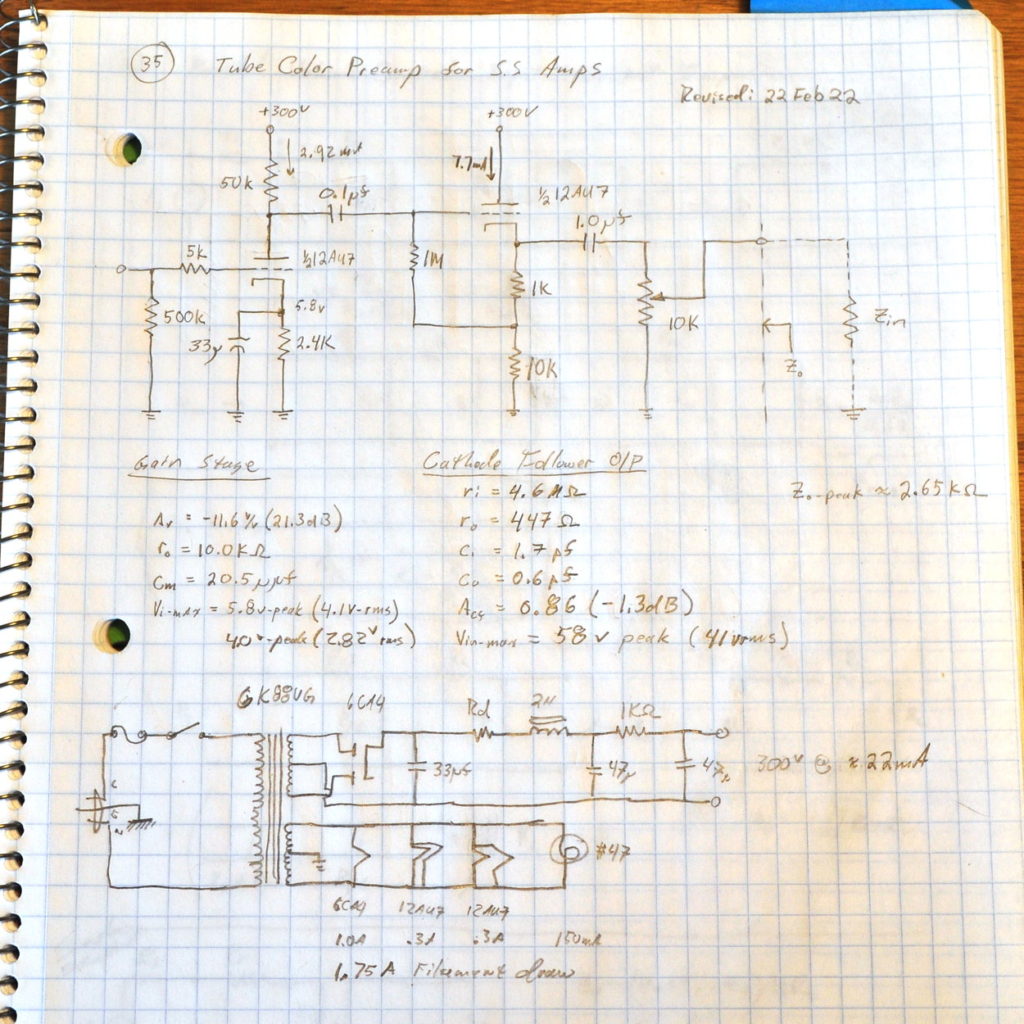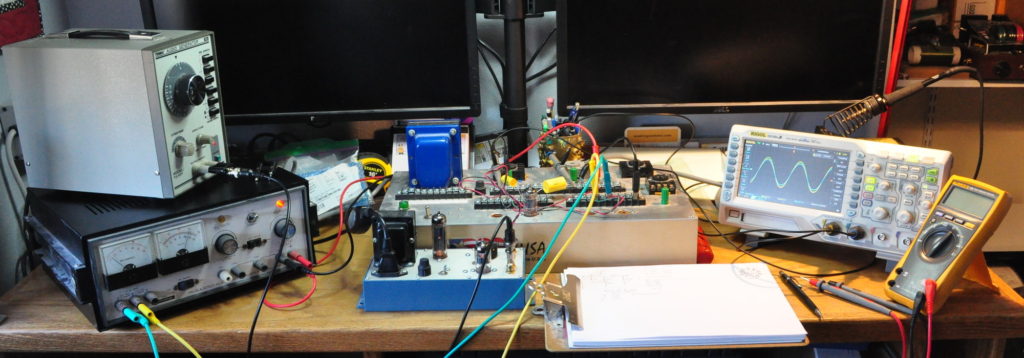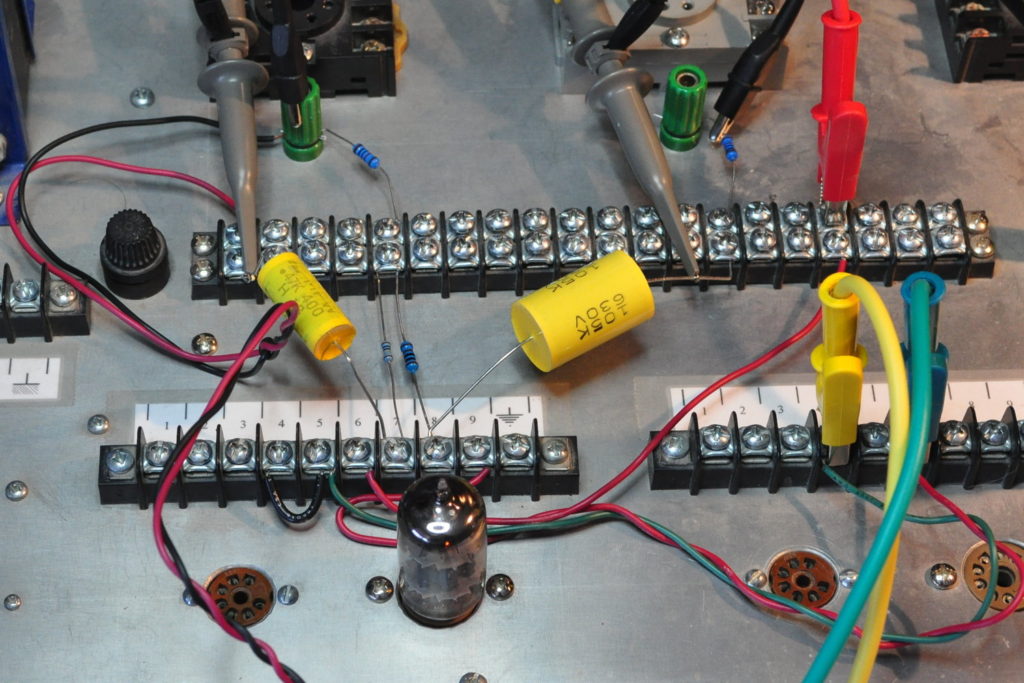Lots of work has been going on the last couple of days working on an alternate buffer design for the 12AU7 “Color” preamp. As readers should know, I was not particularly pleased with the performance of the previous buffer circuit. It was bottoming out at too low a voltage. Now however, I have a simple change which yields much better results.
The change is a relatively simple one. But this simple change is the outgrowth of several design options and two different tested prototypes. I was not joking when I said it’s been a busy two days. But before I explain how the new design came about, I’ll present the revised schematic from my notebook.
The change to the buffer circuit is simple. One resistor, the cathode follower load, changes from 50kΩ to 10kΩ. I have also elected to change the coupling capacitor between stages from 0.047µf to 0.1µf. This is simply to support slightly better low frequency performance. Also note that the improved performance comes at the expense of increased current in the buffer. Total load on the power supply is now about 22mA so plan accordingly when choosing Rd.
The new buffer is actually a much better performing circuit. I will add however, that this is a 300V B+ circuit. The acceptable B+ should not be allowed to fall below about 285V at the absolute lowest. It might even improve performance to increase the B+ to around 310v to 315v. This gives the buffer a little more headroom.
Here is the final successful prototype from this morning.
That’s a 4S “Universal” preamp (with a 12AX7) connected to my signal generator. I’m using the combination to generate the large input voltages required to test the buffer circuit. Here is a quick look at the input and output waveforms with a “close” to maximum input.
The voltage into the buffer here is a little over 46v-peak. Beyond this input level the harmonics begin increasing more than I generally like. But it can go to peaks of over 50v and still be performing very well. At this input voltage the THD was almost all even order (2nd and 4th harmonic) and just slightly over 1%. This buffer will really let the color of the first stage shine through.
The circuit for the buffer really is quite simple. Just three resistors (four is counting the volume potentiometer) and two capacitors per channel. Here’s what it looked like on the prototyping station.
As an added benefit, I got to use one of the preposterously large 1.0µf foil capacitors I ordered which wouldn’t fit in the prototype chassis.
With the gain stage amplification running about 11.4 v/v this allows an input voltage of ≈4.1v peak (or 2.88v RMS) to reach the levels shown in the waveforms above. This means that virtually all standard line level outputs can drive this preamp without overdrive. Just for reference, my iPod touch puts out about 1.0v peak at maximum volume. My Cambridge ACX35 CD player produces about 1.5v peak output on the loudest of tracks, and the sound card in my iMac puts out about 3v peak at full volume and the loudest tracks. And I virtually always reduce the output on my computer sound card.
Now anyone that wants to try out building a color preamp can do so with a better design than the original one I posted. And one that doesn’t require the input pad that I had to install on the prototype. This is an easy and effective way to improve the sound of those inexpensive class-D amp modules which have become so ubiquitous these days.
As always, questions and comments are welcome.





Pingback: Not Quite Done | Cascade Tubes
Are you use a 1K resistor as Rd for the 6K88VG PT? Dan
In this new configuration the total current draw is now 22mA. At 22mA, 1kΩ drops about 22v vs 13.3v in the first version. I used a 4kΩ Rd. With the other 1kΩ dropper in the last stage of the filter this means a total drop of 66.5v. If your conditions are the same (i.e. mains at 122vac) then you’ll likely need 3kΩ total to get down to the same voltage. However, I recommend getting at least 300v, So I would recommend using a 1kΩ Rd initially and only increasing it if your B+ is above 320v.
Pingback: Tube “Color” Preamp for Solid State Amplifiers | Cascade Tubes